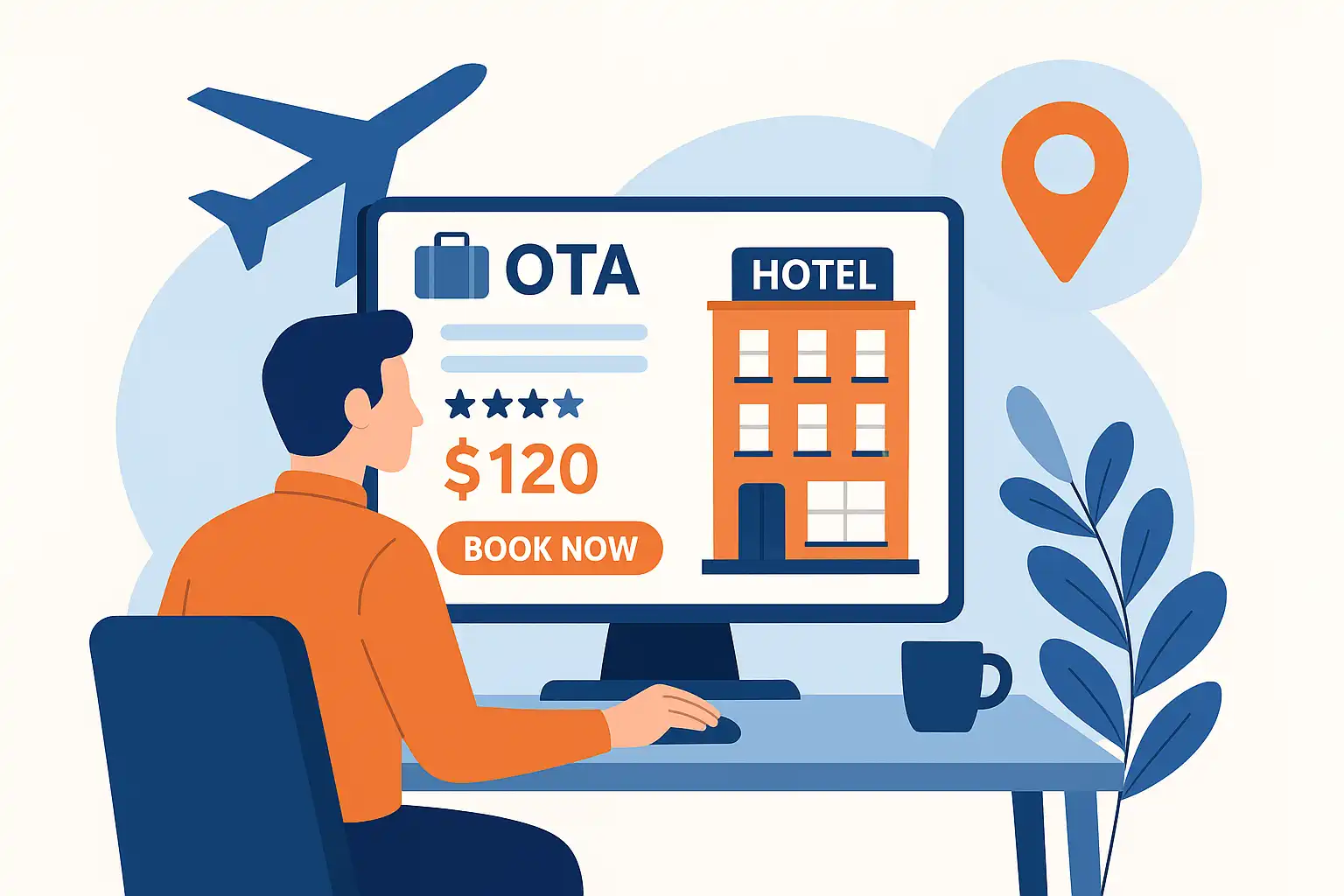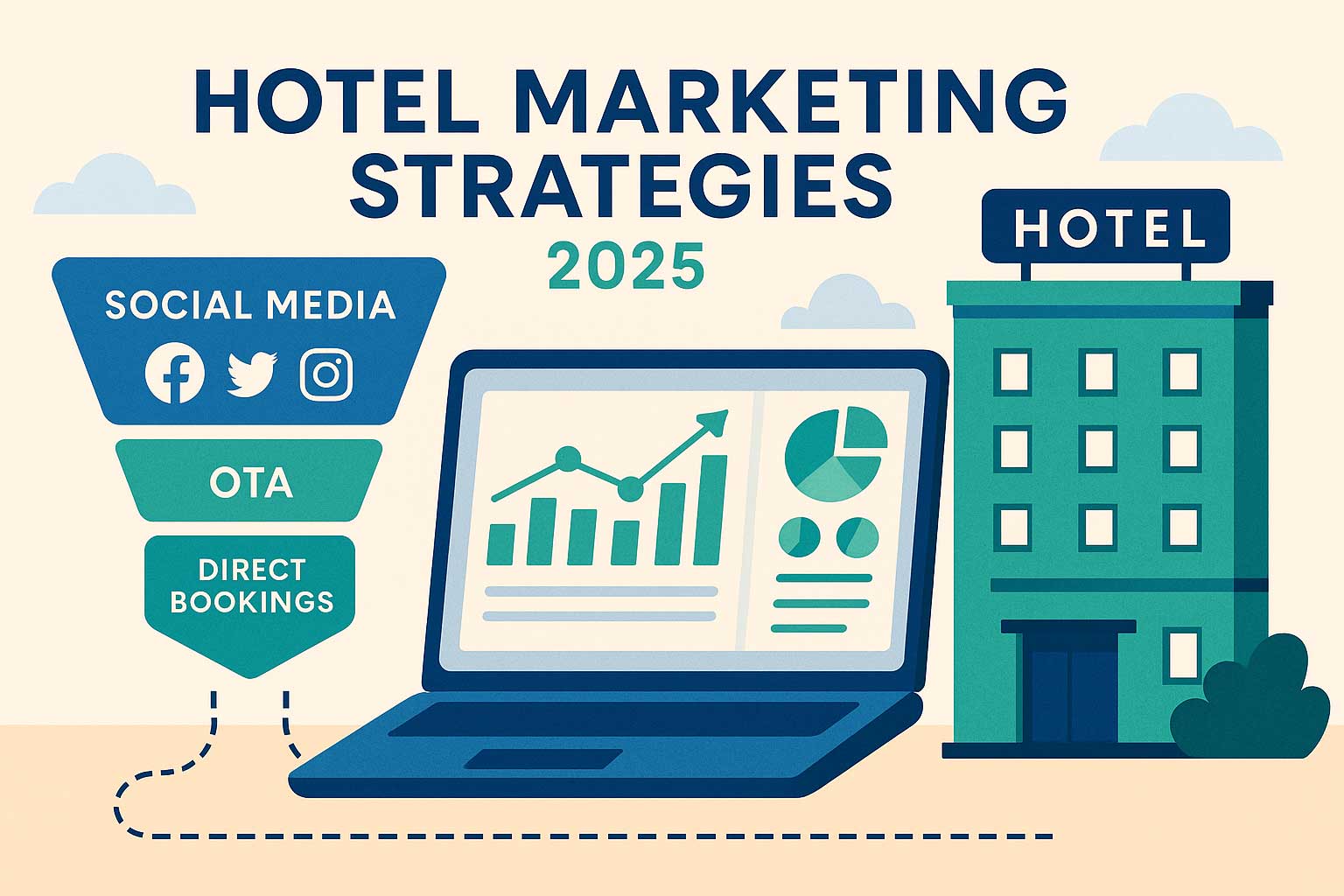OTA Channel Manager: Complete Guide to Online Travel Agency Management
Jul 25, 2025
 Mika Takahashi
Mika TakahashiPopular Categories
Hotel Technology & InnovationHotel Operations OptimizationDigital MarketingIndustry TrendsRevenue ManagementHospitality Industry
Popular Categories
Trending Post

Hotel Walk Letter Template: Professional Guest Communication

Online Travel Agents: What They Are and How They Work

Hotel Security Systems: Modern Protection Solutions

Hotel Advertising: Complete Guide to Boost Bookings and Revenue

25 Hotel Marketing Strategy Ideas for 2025: Complete Guide

AI Reservation Agent: Revolutionizing Hotel Booking and Guest Experience

PMS Communication: Streamlining Property Management Through Effective Guest Messaging
Table of contents
Managing inventory across dozens of online travel agencies can be a manual update nightmare, overbookings and missed revenue opportunities. With travellers booking through Booking.com, Expedia and Airbnb, hotels and vacation rentals need a streamlined solution to keep their hotel online presence up to date.
An OTA channel manager is the central nervous system of modern hospitality distribution, connecting your property management systems to multiple distribution channels at once. This guide will take you through everything you need to know about channel management software, from the basics to advanced optimisation strategies to transform your revenue management.
Whether you’re a boutique hotel owner struggling with manual updates or a growing vacation rental company looking to expand your market reach, understanding how channel managers work is key to staying competitive in today’s digital world.
What is an OTA Channel Manager?
An OTA channel manager is specialized software used by hotels, vacation rentals and property managers to manage availability, rates and content across multiple online travel agency platforms in real-time. This channel manager acts as a middleman between your property’s management systems and online distribution channels like Booking.com, Expedia, Airbnb and dozens of other booking sites.
The main job of a channel manager is to sync room inventory, rates and restrictions across all connected channels at the same time, so you don’t have to update each platform manually. This eliminates the problems that come with managing multiple channels separately, like overbookings, rate discrepancies and outdated availability.
Key Differences from Traditional Property Management Systems
A traditional property management system manages internal operations like reservations, front desk activities and housekeeping schedules. An OTA channel manager focuses on external distribution. The channel management strategy is:
- PMS Integration: Your existing system manages on-property operations
- Channel Distribution: The channel manager manages all external booking platforms
- Data Synchronization: Real-time updates flow between both systems automatically
Modern cloud-based systems may have basic channel connectivity but dedicated channel management software has much more OTA integration, inventory control and automation features that growing businesses need.
Benefits of Centralized Management
Centralized channel management through a dedicated system gives you:
Revenue Optimization: Keep rates consistent across all channels and allow dynamic rate changes based on demand and market conditions. Revenue managers can implement complex rate strategies without having to update dozens of platforms manually.
Operational Efficiency: Eliminate hours of daily admin work by automating inventory updates across all connected channels. Staff can focus on guest experience not data entry.
Market Expansion: Connect to new booking sites and international markets without additional operational complexity. As you grow, adding new channels is a simple configuration not a major operational task.
Risk Mitigation: Prevent overbookings and comply with OTA rate parity requirements with automated monitoring and instant updates across all partner platforms.
Core Features of OTA Channel Managers
Modern channel management systems have advanced features to streamline operations and maximize revenue across all connected platforms.
Real-Time Inventory Synchronization
The foundation of any good channel management system is real-time inventory across all connected online travel agents at the same time. When a guest books a room through any channel, the system updates availability across every other platform instantly, so you don’t get double bookings and have accurate inventory display.
This is done through two-way XML or API connections that update near-instantly. For example, when someone books the last room on Booking.com, that inventory is blocked across Expedia, Airbnb and all other connected channels in seconds.
Automated Rate and Availability Updates
Channel management software eliminates the time consuming process of manually updating rates across multiple platforms. Revenue managers can change pricing strategies, create special offers and set booking restrictions from one interface and it will update all connected channels.
The system ensures seasonal pricing, last minute promotions and inventory restrictions like minimum stay requirements are applied consistently across all partner platforms, so you have rate parity and don’t breach OTA agreements.
Centralized Reservation Management
All bookings, modifications and cancellations from every connected channel flow into one dashboard and integrate with your property management system. This centralization allows automated guest communication workflows, streamlined check-in processes and reporting across all distribution channels.
The system keeps records of booking sources, guest preferences and partner performance so you can optimize your channel management strategy and focus your marketing on the most profitable channels.
Advanced Connectivity and Error Handling
Professional channel managers use robust two-way XML connectivity to ensure data exchange between your systems and OTA platforms while avoiding ota sync errors. This technology standard allows instant booking confirmations and real-time inventory updates while keeping data integrity across all connected systems.
When connectivity issues or mapping errors occur the system has automated error handling with detailed notifications and diagnostic tools. This proactive approach ensures system reliability and allows quick resolution of any technical issues that could impact bookings or guest satisfaction.
Rate Parity and Restriction Management
Having the same rates across all channels is crucial for OTA agreements and avoiding penalties or reduced visibility. Channel management systems enforce rate parity while allowing strategic adjustments based on channel performance and business goals.
The software also manages complex booking restrictions across all platforms, minimum stay requirements, advance booking windows and seasonal blackout dates. These can be set once and applied across all connected channels so you have consistent policies and maximize revenue opportunities.
How OTA Channel Managers Work
Understanding how channel management systems work helps properties get the most out of them and troubleshoot when things go wrong.
API Integration Process
Channel managers connect to each OTA’s back end systems through secure API or XML integrations. This involves credential based authentication and mapping between your property management system, the channel manager and each OTA’s data structure.
The integration process requires mapping of room types, rate categories and property policies to each platform’s specific requirements. For example a “Deluxe King Room” in your PMS might need to be mapped differently across Booking.com, Expedia and Airbnb to ensure accurate representation on each platform.
Real-Time Data Exchange Mechanisms
Modern channel management systems use two way data flows to keep all systems in sync. Availability, rates and inventory data flows from your PMS through the channel manager to each OTA, while reservations and cancellations flow back the other way.
This two way communication happens within seconds of any change so a booking made on one platform updates inventory across all other channels. The system processes these updates automatically in most cases so you don’t need to intervene manually.
Booking Flow and Inventory Management
When a guest books through any connected OTA the booking information flows through the channel manager into your PMS. The system blocks that inventory across all other platforms and can trigger automated confirmation emails and pre-arrival communications.
When a cancellation is made through any channel the inventory is released across all platforms, maximising the opportunity to rebook. The automated process ensures optimal inventory utilisation and minimises the risk of overbookings or lost revenue.
Error Handling and Monitoring
Professional channel management systems have comprehensive monitoring and error handling to ensure reliability. When synchronisation fails due to connectivity issues, API changes or mapping problems the system provides detailed error messages and diagnostic information.
Most systems have automatic retry for failed updates and log all transactions for troubleshooting purposes. This proactive approach ensures the system is reliable and allows you to resolve issues before they impact guest experience or revenue.
Major OTA Platforms Supported
Most channel management systems connect to 150-200+ online travel agents and booking platforms, covering global and regional markets.
Booking.com Integration
Booking.com is the world’s largest OTA so most properties need to be integrated. Channel managers support real-time two-way sync with Booking.com’s systems, including ARI updates, reservation import and instant inventory blocking.
The integration requires careful mapping of room types, rate plans and property policies to match Booking.com’s structure. Properties must configure unique identifiers for each room type and ensure add-on services and amenities are mapped correctly to display on the platform.
Expedia Group Connectivity
Expedia Group has multiple platforms (Expedia, Hotels.com, Vrbo) each with their own requirements and features. Channel managers need to handle different mapping requirements and special features like Expedia’s package rates and merchant inventory models.
The integration covers all Expedia Group brands and includes support for their advanced features like virtual credit card payments and specialized rate types for different market segments.
Airbnb and Alternative Platforms
Modern channel managers support Airbnb integration for vacation rentals and boutique hotels, including ARI updates and booking import. But Airbnb’s structure is unique and requires different content mapping and may have limitations on certain amenities and policies.
The integration supports Airbnb’s instant book feature and can manage the platform’s requirements for vacation rental properties, including detailed house rules and amenity descriptions.
Regional and Specialized Platforms
Professional channel management systems connect to regional platforms like MakeMyTrip for the Indian market, Hostelworld for hostel properties and specialized platforms for specific market segments or geographic regions.
These regional integrations are important for properties targeting specific markets or guest demographics, to reach travelers who book on local platforms or specialized accommodation types.
Global Distribution Systems and Metasearch
Advanced channel managers connect to global distribution systems used by travel agents and corporate booking tools. Many systems also integrate with metasearch platforms like Google Hotels and TripAdvisor to get visibility across the entire travel booking ecosystem.
These connections help properties reach business travelers, group bookings and guests who research accommodations across multiple platforms before making their final booking decision.
Setting Up Your OTA Channel Manager
Setup is key to getting the most out of your channel management system and avoiding common configuration errors that can impact bookings and revenue.
Initial Registration and Verification
The setup process starts with registering your property with the channel management system and each individual OTA. Many online travel agents require comprehensive documentation, property verification and banking information before allowing bookings.
This initial registration phase involves submitting property photos, detailed descriptions, amenity lists and policy information. Some platforms may require additional verification steps or site inspections especially for new properties or properties in certain geographic markets.
Room Type and Rate Mapping
One of the most important part of the setup is mapping your room types and rate categories to each OTA’s structure. This requires attention to detail as incorrect mapping is a leading cause of sync errors and booking problems.
Each platform uses different terminology or categorization systems so properties need to create multiple versions of room descriptions and amenity lists. For example a “Superior Ocean View Room” might need to be configured differently across various platforms to display and search correctly.
Content Synchronization and Management
Modern channel management systems allow for central content management so properties can upload and sync photos, descriptions, amenities and policies across all connected channels. This ensures brand consistency while reducing the time to maintain multiple platform listings.
The content sync process involves detailed mapping of amenities, services and property features to each platform’s categories. This ensures guests can find and understand your property’s offerings regardless of which platform they book through.
Testing and Validation Procedures
Before going live with bookings most systems have a testing mode where properties can validate their setup and identify potential issues. This testing phase includes test bookings, validation reports and sync checks across all connected platforms.
The testing process helps identify mapping errors, connectivity issues and content problems before they impact real bookings. Properties should test all connected channels and review error logs to ensure smooth operation when the system goes live.
Avoiding Common Setup Errors
Several common configuration errors can impact system performance and booking success:
Mapping Inconsistencies: Ensure room types, rate codes and amenity descriptions are mapped correctly across all platforms to prevent booking errors and guest confusion.
Currency Configuration: Verify currency settings match each platform’s requirements and exchange rate handling is set up for international markets.
Policy Alignment: Ensure cancellation policies, payment terms and house rules are set up the same across all channels to prevent guest disputes and compliance issues.
Content Quality: Maintain high-quality, consistent content across all platforms to maximize visibility and conversion rates while ensuring compliance with each platform’s content guidelines.
Common OTA Channel Manager Issues and Solutions
Even with a well configured channel management system you can still encounter technical and operational issues that need to be addressed quickly.
Synchronization and Connectivity Problems
Rate and availability synchronization failures are usually caused by temporary connectivity issues, OTA platform API changes or broken mapping configurations. This can result in outdated inventory or pricing across channels.
Resolution is systematic, starting with connectivity verification, then mapping validation and error log analysis. Most modern systems have detailed error reporting and automatic retry to minimize the impact of temporary issues and channel manager inventory errors.
Mapping and Configuration Errors
Incorrect mapping of room types, rate codes or product identifiers can prevent inventory synchronization and result in booking failures. These errors will show as “unknown rate code” notifications or missing inventory on specific channels.
Resolution requires careful review of mapping configurations, validation against each channel’s requirements and systematic testing to ensure connectivity. Properties should maintain a record of mapping configurations to aid troubleshooting.
Authentication and API Issues
System login failures or expired API credentials can break communication between the channel manager and OTA platforms. These require reauthentication with the affected platforms and may involve working with OTA technical support teams.
Prevention is monitoring connection status and proactive credential management. Many systems have automated alerts for authentication failures and pending credential expirations.
Performance and Timeout Issues
Inventory update timeouts and service interruptions can be caused by high system load, network issues or OTA platform infrastructure problems that need to be resolved through channel manager troubleshooting. This can result in delayed updates or temporary booking disruptions.
Modern channel management systems have automatic retry, load balancing and alternative communication paths to minimize the impact of performance issues. System administrators should monitor performance metrics and have a backup communication method when possible.
Booking and Reservation Error Management
Some booking errors require specific troubleshooting to keep guests happy and operational efficient.
Rate Code and Product Mapping
Unknown rate code notifications mean rate configurations in the property management system don’t match OTA rate structures. Review rate mapping and work with OTA support teams to get it right.
Missing product code issues prevent rate plans from showing on OTA’s, reducing booking opportunities. Regular product mapping audits and proactive rate display monitoring across all channels will prevent these issues.
Currency and Financial Configuration
Currency mismatch errors will cause booking rejections or incorrect pricing on OTA’s. Properties in multiple markets must configure currency handling and exchange rate management to get pricing right across all channels.
Many channel management systems have automated currency conversion and validation features to prevent these issues. Monitor exchange rates and pricing accuracy across international markets to stay competitive.
Modification and Cancellation Processing
Synchronization delays in modifying or cancelling bookings can cause guest experience issues and overbooking. Robust error handling and automatic retry functionality will ensure changes are synced across all systems.
Properties should keep detailed audit trails of all booking changes and monitor proactively to identify and fix sync issues quickly.
Best Practices for OTA Channel Management
Proven strategies for channel management can boost performance and revenue across all platforms.
Rate Parity and Compliance Management
Keeping rates consistent across all channels is key to avoiding OTA penalties and maximum visibility. Channel management systems should enforce rate parity while allowing for strategic adjustments based on channel performance and market conditions.
Regular rate checking and proactive compliance management means strong relationships with channel partners and maximum bookings across all platforms.
Performance Monitoring and Analysis
Regular analysis of channel performance metrics including bookings, conversion rates and revenue contribution helps to optimise channel management. Properties should track performance across all connected platforms and adjust inventory based on partner performance and business objectives.
Advanced analytics allows properties to see trends, optimise pricing, make data driven decisions on channel partnerships and marketing spend.
Strategic Inventory and Revenue Management
Dynamic inventory allocation based on real-time demand, seasonality and channel profitability maximises revenue and minimises commission costs. Revenue managers should regularly review channel performance and adjust allocation to meet sales targets and business goals.
Seasonal pricing and promotional activity can be applied across multiple channels at once, so properties can respond quickly to market changes and competition.
Content and Marketing Optimisation
Regular updates to property content, photos and amenity descriptions means properties stay competitive across all channels. Consistent high quality content presentation strengthens the hotel’s online presence and conversion rates across all platforms.
Properties should monitor guest feedback and reviews across all channels to identify opportunities to improve and stay competitive in their target markets.
Choosing the Right OTA Channel Manager
Choosing the right channel manager for your property is all about evaluating features, costs and integration that fit your business needs.
Connectivity and Integration
The number of OTA connections is key, with top systems supporting 150-200+ direct connections to major and regional booking sites. Properties should identify which channels are most important for their target markets and make sure they are covered.
Integration with existing property management systems, booking engines and revenue management tools is equally important for operational efficiency and data consistency across all systems.
Pricing Models and Costs
Channel managers use subscription based pricing models, costs vary depending on property size, number of connected channels and features required. Properties should evaluate total cost of ownership including setup fees, ongoing subscriptions and any transaction based charges.
When comparing pricing models consider the scalability costs as the business grows and more channels or properties are added to the system.
Support and Service
Reliable support is critical given the mission critical nature of channel management. Properties should evaluate support availability, response times and technical expertise when choosing a system provider.
Comprehensive onboarding assistance, training programs and ongoing account management ensures a smooth implementation and optimal system usage over time.
Scalability and Advanced Features
Properties should consider their growth plans and evaluate if the potential systems can handle adding more properties, markets or distribution channels without requiring system changes or migrations.
Advanced features like AI powered revenue optimization, automated content management and sophisticated reporting can give you a competitive edge and operational efficiency as you grow.
Future of OTA Channel Management
The channel management industry is changing with new technologies and customer preferences reshaping how properties connect with potential guests.
AI and Machine Learning
Artificial intelligence and machine learning are being added to channel management systems to optimise pricing, inventory and revenue performance. These advanced systems can analyse market conditions, competitor pricing and historical performance to make real time adjustments to maximise revenue.
Early adopters of AI powered channel management are seeing significant improvements in average daily rates and occupancy, some properties are seeing 10% or more improvement in key performance metrics.
Mobile First Distribution
With over 60% of travellers booking through mobile devices, channel management systems are adapting to support mobile optimised content and booking experiences. Properties need to ensure their channel management strategies account for mobile user behaviour and booking habits.
This means optimising content for mobile, supporting mobile specific booking features and fast loading times across all connected platforms.
Sustainability and Environmental Focus
Growing traveller interest in sustainable and environmentally friendly accommodations is driving new content requirements and filtering options across OTA’s. Channel management systems are adding support for environmental certifications, sustainability metrics and eco friendly amenity descriptions.
Properties that proactively report on sustainability through their channel management system may gain a competitive advantage with environmentally conscious travellers.
Direct Booking and Disintermediation
Many properties are looking to increase direct bookings through their own website while maintaining strong OTA relationships. Advanced channel management systems support this strategy by allowing seamless integration with direct booking engines and metasearch platforms.
The challenge is to balance inventory across channels to maximise direct bookings without breaching OTA agreements or losing visibility on key distribution platforms.
Channel management technology is advancing with broader integrations connecting properties not just with traditional OTA’s but also with global distribution systems, social media booking platforms and emerging guest experience technologies that create new revenue and guest engagement opportunities.
The hospitality industry’s digital transformation requires properties to stay ahead of the technology curve while keeping focus on guest satisfaction and operational efficiency. Effective channel management is key to successful revenue management in a complex distribution landscape.
Properties that invest in robust channel management systems and develop a distribution strategy will be well placed for long term success as the industry moves towards more automated, intelligent and guest centric booking experiences.
Whether you manage a single boutique hotel or a growing portfolio of vacation rentals, effective channel management with the right technology solution is crucial to maximise revenue and stay competitive in today’s hospitality market.
